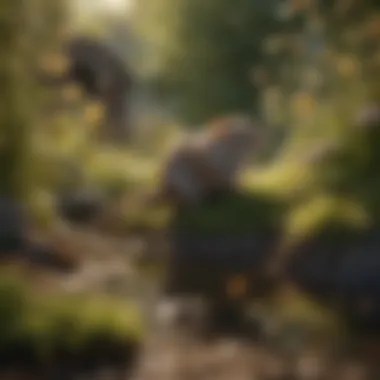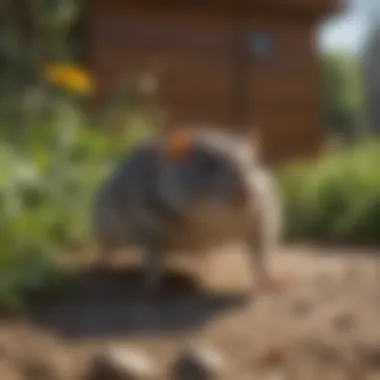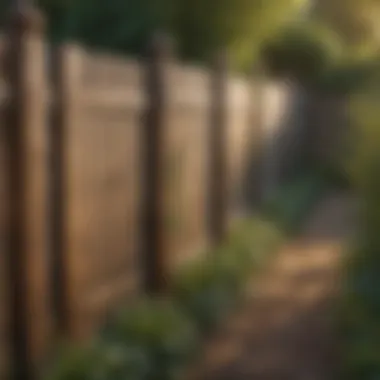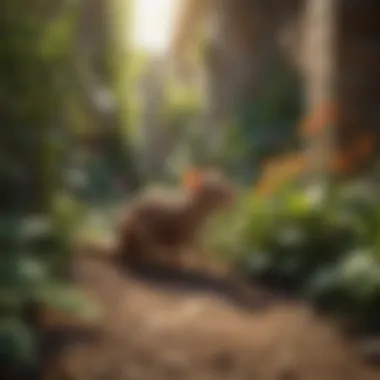Effective Strategies to Remove Voles from Your Garden


Intro
In gardens around the world, voles can become unwelcome visitors. These small rodents, often mistaken for mice, have distinct habits and behaviors that can lead to significant damage if not managed effectively. Understanding how voles operate is crucial for any homeowner or gardening enthusiast. This article will delve into comprehensive strategies to manage vole populations in gardens, focusing on preventative techniques and sustainable pest control solutions. By gaining insight into vole behavior, identification methods, and their ecological impact, you can develop a proactive approach that protects your garden without relying on harmful chemicals.
Understanding Voles and Their Behavior
Understanding the behavior and characteristics of voles is crucial for anyone dealing with infestations in their gardens. Gaining insight into these rodents allows for more effective management. This section lays the foundation for identifying signs of vole activity and implementing effective control strategies. By appreciating their life cycle and tendencies, backyard gardeners can not only respond quickly to threats but also implement preventative measures.
Defining Voles
Voles are small, burrowing rodents belonging to the family Cricetidae. They are often confused with moles, but they have distinct differences. Voles have compact bodies, short tails, and a more rounded snout. Typically, their fur is brown to gray-toned, which helps them blend into their environment. These creatures play a significant ecological role. In gardens, however, they can cause substantial damage by feeding on plant roots, bulbs, and tubers. Understanding their physical traits supports gardeners in recognizing the threat they pose as well as distinguishing them from other garden pests.
Vole Habitat and Diet
Voles thrive in a variety of habitats. They prefer areas with ample ground cover such as grasses, herbs, and dense shrubs. This preference offers them safety from predators. They build extensive tunnel systems underground, which provide warmth and protection from the elements. Their diet primarily consists of plant materials, including seeds, stems, and roots. They are known particularly for their fondness for tender vegetables and seedlings. Knowing their dietary needs helps gardeners take proactive steps to safeguard their plants from these hungry rodents.
Vole Reproduction and Lifespan
Voles reproduce quickly, which exacerbates infestations. A female vole can have multiple litters each year, typically ranging from three to six young per litter. They reach sexual maturity in just a few weeks, allowing populations to grow rapidly in suitable environments. The lifespan of a vole is usually around three to six months in the wild, though some may live longer in less threatened settings. This swift breeding cycle means that once voles invade a garden, they can cause widespread damage before effective control measures can be executed.
Understanding the breeding habits of voles is essential for implementing control strategies effectively.
By comprehending these aspects of vole behavior, you equip yourself with the necessary knowledge to manage them effectively in your garden.
Identifying a Vole Infestation
Identifying a vole infestation is critical for managing their impact on your garden. Voles can cause confusion with other pests, leading to misdiagnosis of the problem. Recognizing the specific signs of their activity not only minimizes damage to your plants but also informs the control strategies you choose. Moreover, understanding the severity of the infestation helps prioritize your response, ensuring efficient use of resources.
Signs of Vole Activity
Detecting vole activity early can significantly reduce the extent of garden damage. Some common signs include:
- Surface runways: Voles create shallow pathways through ground cover. These trails can be identified by the flattened grass or matted leaves along the soil surface.
- Burrows: Voles dig extensive networks of tunnels, often about 2 inches wide, near their feeding areas. Look for small entrances, typically situated in grassy or mulched areas.
- Gnaw marks: Voles tend to munch on roots, bulbs, and stems. Fresh teeth marks on these plants are a clear indication of their presence. While not all signs guarantee a vole problem, their identification can guide effective intervention.
Comparison with Other Garden Pests
Comparing voles with other common garden pests is crucial in accurate pest management. Voles differ from moles and gophers in behavior and damage.
- Moles: These creatures primarily burrow underground searching for insects and grubs. Their presence is usually marked by raised mounds of soil.
- Gophers: Different from voles, gophers tend to create larger burrows and produce distinctive soil mounds in your garden. Understanding these behaviors is key in implementing the proper control measures. Misidentifying the pests may cause ineffective treatment.
Assessing the Severity of the Infestation
Once signs of voles are confirmed, it's necessary to assess the severity of the infestation. Begin by evaluating the extent of the damage:
- Check the size of the affected area: Larger areas affected by signs of vole activity indicate a more established population.
- Count the number of burrow entrances: Multiple entrances suggest a higher density of voles, leading to more significant remedial measures.
- Evaluate plant damage: More extensive damage to major plant roots may require immediate action.
Evaluating the severity allows gardeners to decide on whether they need immediate action or if they can implement preventative measures. Proper assessment is fundamental for crafting a targeted approach, ensuring effectiveness in vole management.
Remember, early detection and accurate identification are vital in combating vole infestations.


Preventative Measures for Vole Control
Implementing preventative measures against voles is essential for maintaining a healthy garden. These strategies focus on reducing the likelihood of a vole infestation before it begins. A proactive approach not only minimizes damage to plants but also creates a more sustainable gardening environment.
Landscape Modifications
Altering the landscape can effectively deter voles from invading your garden. One major modification involves reducing dense vegetation where voles prefer to hide. Keeping your lawn well-maintained and free of excess debris is vital. Mowing regularly prevents tall grasses from providing cover.
Another useful strategy is planting gardens in well-maintained plots. Open, exposed areas discourage voles, as they prefer dense cover for safety. You should consider using raised beds. These not only facilitate better drainage but also create barriers. Adopting a clean and organized approach in the garden contributes to a less inviting environment for voles.
Plant Selection and Placement
Choosing the right plants plays a crucial role in deterring voles. For gardeners, it is essential to select plants that voles find unappealing. Plants such as lavender, marigolds, and daffodils tend to repel these rodents. Additionally, spacing plants appropriately can reduce the risk of heavy undergrowth, which serves as an attraction for voles.
In terms of placement, try to avoid clustering plants closely together. As voles seek shelter, they are likely to establish a presence in closely spaced plantings. Instead, maintain some distance between plants. This reduces the likelihood that voles will find a suitable habitat.
Creating Barriers
To physically block voles from entering your garden, consider creating barriers. One effective method is to install underground fencing. This fencing should extend at least 12 inches below the ground surface. Materials like hardware cloth are suitable for this purpose. In addition, ensuring that the perimeter of your garden is tightly sealed with no gaps will assist in keeping voles at bay.
Another viable solution involves using mesh around sensitive plants. This adds a layer of protection, especially for young saplings and seedlings. The goal of barriers is to provide a strong defense against unwanted pests like voles while allowing other beneficial species to thrive.
In summary: Preventative measures are often more effective and sustainable than reactive control methods. By modifying your landscape, selecting the right plants, and erecting barriers, you create an unwelcoming atmosphere for voles, enhancing the overall health of your garden.
Physical Control Methods
Physical control methods are essential in managing vole populations effectively. These methods focus on immediate, tangible actions that yield results without relying on chemical treatments. By incorporating physical strategies, gardeners can implement practical solutions that align with eco-friendly principles. This approach not only safeguards the garden but also minimizes ecological disturbances.
Trapping Techniques
Types of Traps
Types of traps are critical in any vole control strategy. These devices vary in design and mechanics, with each type offering certain benefits. Snap traps are popular due to their simplicity and effectiveness. They are designed to quickly kill voles upon activation. Another effective option includes live traps, which capture voles unharmed, allowing for relocation without killing the animal. This is important for gardeners seeking ethical solutions. However, live traps require regular checks to prevent stress or mortality for the captured animals. Each type has unique features, so choosing the right one depends on the specific goals of the gardener.
Placement Strategies
Placement strategies can make or break the effectiveness of trapping. Positioning traps close to evidence of vole activity is crucial. Areas where they have been seen active or spots with signs like burrows or droppings should be prioritized. This tactical approach helps ensure higher capture rates. A key aspect of placement is understanding vole behavior; they tend to follow established pathways. Setting traps along these trails increases the likelihood of success, which is a strategic advantage. It’s recommended to check traps regularly to maintain their functionality and capture efficiency.
Handling and Safety
Handling and safety protocols cannot be overlooked when employing traps. Gardners must use caution to avoid injuries during setup and removal. Wearing gloves is recommended to protect against disease transfer and to prevent gerneration of odors that may deter voles. It is also vital to follow the instructions provided with each trap. The unique feature of proper handling lies in maintaining a clean and safe environment. Neglecting these practices can lead to accidents or ineffective trapping, resulting in prolonged vole problems.
Manual Removal Strategies
Manual removal strategies include physical methods that directly remove voles from the garden. Hand-picking voles or digging out burrows can be labor-intensive but effective. Strategies often involve locating burrows and blocking entrances or using tools like shovels to disrupt their nesting conditions. This direct approach requires persistence and effort, but it can lead to visible results. Understanding vole habits is key to successful manual removal.
Chemical Control Options
Chemical control options play an important role in managing vole populations effectively. While prevention through habitat modification and physical barriers provides a vital first line of defense, sometimes these strategies may not be enough. In such cases, chemical methods, when used correctly, can help in reducing the severity of infestations. It is crucial to utilize these options responsibly, keeping in mind the potential impact on the surrounding ecosystem, pets, and humans.


Types of Rodenticides
When considering rodenticides for voles, it is essential to understand their classification and usage. Three primary types of rodenticides are commonly used:
- Anticoagulants: These poisons disrupt the blood clotting process in mammals. They may require multiple feedings over several days to yield results. Common anticoagulant products include Bromadiolone and Brodifacoum.
- Acute Rodenticides: These types offer immediate results, often leading to death within hours of ingestion. Examples include Zinc Phosphide. Care should be taken as they may require only a single feed, raising the risk of non-target wildlife exposure.
- Non-toxic alternatives: These products do not rely on poison but may contain ingredients that naturally repel voles. Using plant-based repellents can sometimes deter voles from gardens without the risks associated with traditional rodenticides.
It is vital to check local regulations before using rodenticides, as some may be restricted or require special licenses.
Environmental Considerations
Using chemicals in any setting brings about environmental concerns. Some important considerations to keep in mind include:
- Non-target species: Rodenticides can affect animal species that are not intended targets. Birds, pets, and beneficial wildlife can ingest these poisons, causing unintended harm.
- Soil and water contamination: Chemicals can seep into the ground, affecting soil and water quality. Even low quantities of rodenticides can disrupt soil ecosystems and lead to adverse effects on plants and microorganisms.
- Bioaccumulation: Some chemicals may accumulate in the food chain as predators consume poisoned voles, posing risks to larger species and disrupting ecological balance.
To mitigate these risks, consider using rodenticides as a last resort and always adhere to guidelines for application. The use of traps, barriers, and natural repellents can often be safe alternatives that promote a healthier garden environment.
Ecological Approaches to Vole Control
Ecological approaches to vole control are critical for creating a healthy garden ecosystem. Unlike chemical treatments, these methods focus on maintaining balance in the environment. By emphasizing natural dynamics, these approaches not only help manage vole populations but also preserve the integrity of the garden's ecosystem.
The benefits of ecological methods are clear. They reduce the risk of chemical exposure to beneficial organisms, such as pollinators and soil microbes. Further, these strategies promote biodiversity, making gardens more resilient against a wide range of pests. Gardeners who opt for ecological management often find that their gardens thrive not just now but also in the long run.
Promoting Natural Predators
Encouraging the presence of natural predators is an effective ecological strategy. Predators like owls, hawks, and snakes can help manage vole populations by preying on them. To make your garden more inviting to these predators, you can create suitable habitats and food sources. Here are a few suggestions:
- Install Owl Boxes: These boxes provide nesting sites for owls, which are known to control rodent populations.
- Plant Native Vegetation: Native plants can attract various insects and birds that prey on voles.
- Provide Water Sources: Birdbaths or small ponds can attract birds and other predators.
By promoting these creatures, gardeners can benefit from a natural form of control that aligns with a holistic approach to gardening.
Habitat Restoration Techniques
Restoring native habitats not only benefits the ecosystem but also aids in vole management. Healthy environments can discourage rodents from becoming overly populated. Here are some habitat restoration techniques to consider:
- Remove Excessive Debris: Clearing away brush and debris can reduce hiding spots for voles.
- Create Zones of Diversity: Planting a variety of plants can provide shelter for natural predators and make areas less favorable for voles.
- Water Management: Proper water management can prevent excessive moist areas, as voles thrive in wet conditions.
Through these techniques, a gardener can create an environment that strives to balance plant needs, predator presence, and pest control, which is essential for long-term garden health.
Using ecological approaches reduces reliance on harmful chemicals and fosters a sustainable garden environment.
Evaluating Control Method Effectiveness
Evaluating control method effectiveness is critical for gardeners dealing with vole infestations. It allows homeowners to assess which strategies work best in their specific landscapes, ensuring successful management of vole populations. This section focuses on what to consider when evaluating these methods, along with their benefits.
The process begins with establishing baseline data about the vole population. Observing initial signs of the infestation and noting their activity helps in creating a point of reference. Once control methods are implemented, this data becomes important for comparison. Finally, effective evaluation leads to informed decisions, adapting techniques as necessary for future challenges.
Monitoring and adapting your approach can save time and resources in the long run.
Monitoring Vole Populations


Monitoring vole populations is essential for understanding their dynamics and the overall effectiveness of control measures. Regular inspections of your garden can reveal changes in activity levels. Use the following methods for effective monitoring:
- Regular Visual Inspections: Check for signs like tunnels, droppings, or burrows in your garden.
- Tracking Changes: Note fluctuations in plant damage or holes in the soil over time.
- Data Recording: Maintain a log that records observations along with dates to track patterns.
By maintaining an organized record, you can make timely decisions based on the changes observed, indicating whether the chosen control methods are effective or need adjustment.
Adapting Strategies for Long-Term Success
Adapting strategies is crucial for long-term success when managing vole populations. A single method may not provide permanent solutions, as vole behaviors and environmental conditions can change. To remain effective, gardeners must:
- Evaluate Current Methods: Assess the effectiveness of your ongoing approaches regularly.
- Diversify Techniques: Implement a mix of physical, chemical, and ecological strategies to prevent adaptability from voles.
- Continually Educate Yourself: Stay updated on latest research and successful practices about vole control.
Long-term success in managing voles is not only about initial control but rather about an ongoing commitment to understanding and adapting to the conditions in your garden.
By focusing on evaluation and adaptation, gardeners can ensure that vole management remains effective, contributing to a healthier garden environment.
Legal and Ethical Considerations
When engaging in the management of vole populations, it is crucial to understand the legal and ethical dimensions involved. Pest control is not merely a matter of efficiency; it also encompasses responsibility towards the environment, public welfare, and the preservation of wildlife. Hence, recognizing the laws and ethical guidelines can prevent unnecessary harm and potential legal repercussions.
Regulations on Pest Control
In various regions, regulations govern the use of specific pest control methods, including traps and rodenticides. Homeowners must be well-informed about local laws to ensure compliance. These laws are in place to protect non-target species and the environment. For instance, some jurisdictions prohibit certain rodenticides due to their toxicity to pets or wildlife.
Before taking action, it is wise to consult resources such as local wildlife agencies or agricultural departments to understand applicable laws, including the necessary permits for trapping.
Additionally, there are specific regulations regarding the disposal of dead voles and the use of traps. Each of these factors influences how one should approach vole control. Homeowners may also want to consider humane options that align with legal guidelines to avoid unnecessary suffering.
Ethical Pest Management Practices
Adopting ethical pest management practices translates into a more sustainable approach toward controlling vole populations. The core principle behind ethical pest management is to minimize harm to other species and the ecosystem. Here are some essential methods:
- Humane Trapping: Utilizing traps that capture voles alive, allowing for relocation, is a common ethical practice. It is essential to check traps regularly to reduce stress for the captured animal.
- Chemical Use Minimization: If chemicals are necessary, choosing eco-friendly options is critical. Many over-the-counter rodenticides pose risks to non-target wildlife.
- Long-Term Strategy Development: Rather than resorting to quick fixes, it is advisable to create sustainable garden practices. Improving soil health and plant resilience can reduce the attractiveness of gardens to voles without harmful methods.
In summary, understanding legal and ethical considerations in vole control is key for gardeners. It ensures that actions taken are not only effective but also responsible. Approaching pest management with these principles fosters a healthier garden environment and respects the delicate balance of local ecosystems.
Finale
In this article, we focused on effective strategies for managing vole infestations in gardens. The comprehensive nature of the discussion highlighted specific methods that can significantly reduce vole populations while maintaining the overall health of the garden.
Recap of Methods Discussed
The methods we explored include both physical and ecological approaches. Key strategies are:
- Preventative Measures: Modify landscapes by implementing barriers and choosing plants that deter voles.
- Physical Control: Utilize trapping methods that align with humane practices and local regulations.
- Chemical Control Options: When necessary, apply rodenticides carefully while considering environmental impact.
- Ecological Approaches: Encourage natural predators and restore habitats that promote balance in local wildlife.
These various control measures not only focus on removing voles but also on preventing future infestations. Each strategy carries its specific benefits and considerations. A long-term view is vital, as addressing the root causes of vole behavior is essential for a healthy garden.
Future Considerations for Gardeners
Looking ahead, gardeners must remain informed and adaptive. Here are several key considerations going forward:
- Stay Informed on Regulations: Keep updated on local pest management regulations to ensure compliance while pursuing control strategies.
- Monitor Environmental Impact: Evaluate the broader ecological implications of pest control methods, focusing on sustainability.
- Adapt and Innovate: As new research emerges, be prepared to adjust tactics and adopt new technologies or methods that can enhance effectiveness.
- Educate Community: Share knowledge about humane vole control with neighbors to foster a collaborative approach in the community.
By embracing a thoughtful and informed perspective, gardeners can nurture their landscapes effectively while minimizing conflicts with voles. This ensures a thriving environment for both plants and wildlife.



